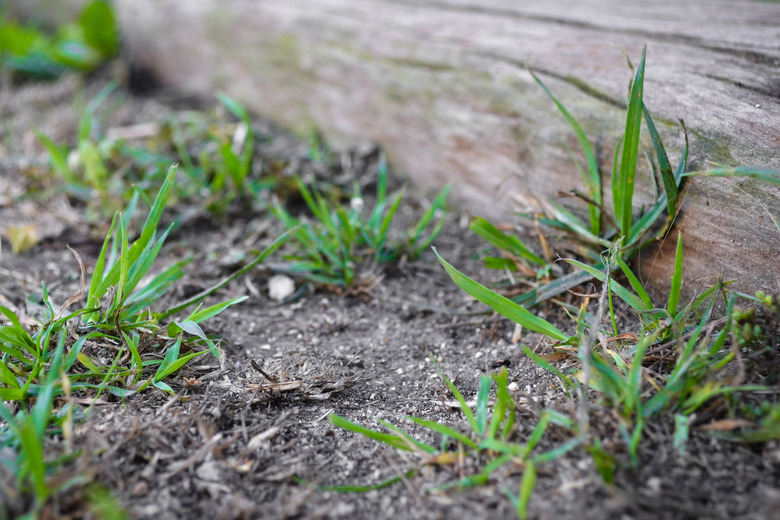How To Stop Grass And Weeds From Growing Close To A Fence
We may receive a commission on purchases made from links.
Figuring out how to stop grass and weeds from growing close to a fence saves endless weeding and creates a neat, tidy look. Solutions vary according to the garden's style and the grass type. Trim excess growth before starting work and speak to your neighbors before spraying herbicides along boundary lines because they may have plants they want to protect.
Maintain an Edge
Maintain an Edge
To stop grass and weeds from growing close to a fence, one option is a neat and unobtrusive barrier in the form of a shallow trench cut with a spade. Mark a line 5 or 6 inches from the fence and parallel to it and push an edging spade 4 inches into the soil along the line. Lever the spade upward toward the fence, lifting out a plug of grass and weeds.
Continue along the fence to create a trench of bare soil. Cut the line in the same way two or three times a year during the growing season to prevent grass and weeds invading the trench. This solution is effective for lawn grasses that grow in clumps, such as tall fescue (Lolium arundinaceum), which grows in U.S. Department of Agriculture plant hardiness zones 4 through 7.
Fill a Trench With Mulch
Fill a Trench With Mulch
You can take the trench idea a step further to stop grass and weeds from growing close to a fence. A trench filled with landscape mulch close to a fence deters grass and weeds by smothering them and preventing them from being able to grow.
Dig a trench next to the fence 4 inches deep and 8 inches wide. Spread landscape fabric along the trench and fill it with a mulch such as wood chips, bark chips, or gravel. Gravel suits formal gardens.
This method is effective for perennial ryegrass (Lolium perenne, zones 5-7) and other clump-forming grasses. Don't create a mulch-filled trench if the fence is at the bottom of a slope because heavy rainfall will fill the trench, wash the mulch away and rot a wooden fence.
Create a Hardscape Barrier
Create a Hardscape Barrier
Bricks, pavers and other hardscaping materials create an effective long-term barrier to stop grass and weeds from growing close to a fence. Bermudagrass (Cynodon dactylon, zones 7-10), which spreads sideways through underground shoots, struggles to invade hardscaping.
Dig a trench 1 1/2 inches deeper than the bricks or pavers and 1 inch wider next to the fence. Lay landscape fabric in the trench and fill with 2 inches of sand. Lay the bricks or pavers on top of the sand and hammer them gently with a rubber mallet to slot them tightly into place and level them.
Check to make sure they're even, using a builder's level. The top of the bricks or pavers should be 1/2 inch higher than the surrounding ground. Fill any gaps with sand.
Use Herbicides for Invasive Plants
Use Herbicides for Invasive Plants
Herbicides control invasive grass and weeds growing close to a fence and prevent regrowth. Put on a long-sleeved shirt, long pants and protective gloves, and spray a ready-to-use 2 percent glyphosate product over the existing growth on a dry, still day when the grass and weeds are actively growing. When the growth has died, which may take up to two weeks, remove it.
Glyphosate kills most plants, so don't spray it on any plants you wish to keep. Spread a pre-emergent weedkiller, such as a 1.47 percent trifluralin product, at the rate noted on the label, and irrigate to activate the grass and weed barrier. Alternatively, apply both herbicides according to the manufacturer's instructions. A 1.47 percent trifluralin product prevents grass and weed regrowth for three months, providing the soil surface isn't disturbed.
